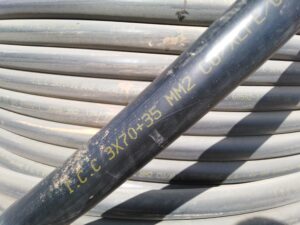If you are looking for a safe and efficient way to organize and protect cables, you may have come across two terms: cable tray and wireway.
Although both cable tray and wireway perform the same function, there are significant differences between the two that are worth understanding.
In this article, we’ll delve into what cable trays and wireways are, how they differ, and what factors to consider when choosing between them.
Table of Contents
What is a Cable Tray?

A cable tray is a support system used to hold cables in place, typically used in industrial settings.
It consists of a series of metal or plastic supports, called rungs, which are connected by a network of cables.
Cable trays can be installed overhead, under floors, or on walls, depending on the application. They are available in a variety of shapes, sizes, and materials, including aluminum, steel, fiberglass, and PVC.
What is a Wireway?
A wireway, also known as a trough or a duct, is a metal or plastic enclosure used to house and protect electrical wiring.
Wireways can be mounted on walls or ceilings and are typically used in commercial and industrial settings.
They are available in various sizes and configurations, such as straight sections, elbows, tees, and crosses.
How do Cable Trays and Wireways differ?
Although cable trays and wireways share some similarities, such as their function, there are some key differences between the two:
Design
Cable trays have an open design, with a series of rungs that support the cables. This allows for easy access to the cables for maintenance and troubleshooting.
Wireways, on the other hand, have a closed design, with a cover that encloses the wiring. This provides additional protection against dust, dirt, and other contaminants.
Cable Capacity
Cable trays are designed to support large quantities of cables, with a high cable capacity. Wireways, on the other hand, have a lower cable capacity and are typically used to house smaller numbers of wires.
Installation
Cable trays can be installed in a variety of ways, including overhead, underfloor, or wall-mounted.
Wireways are typically installed on walls or ceilings, as they are not designed to support heavy loads.
Flexibility
Cable trays offer greater flexibility when it comes to routing cables, as they can be bent and configured to fit around obstacles. Wireways, on the other hand, have a fixed shape and are less flexible.
Cost
Cable trays tend to be more expensive than wireways, due to their higher cable capacity and greater flexibility.
Which one should you choose?
When deciding between cable trays and wireways, there are several factors to consider:
- Cable Capacity: If you need to support a large number of cables, a cable tray is likely the better choice.
- Flexibility: If you need to route cables around obstacles, a cable tray may be the better choice.
- Protection: If you need to protect your cables against dust, dirt, and other contaminants, a wireway may be the better choice.
- Installation: If you need to support heavy loads, a cable tray may be the better choice.
- Cost: If cost is a significant factor, a wireway may be the better choice.
In summary, cable trays and wireways are both useful tools for organizing and protecting cables, but they have different strengths and weaknesses.
By considering the factors above, you can make an informed decision about which option is best for your particular application.
Comparison Table: Cable Trays vs. Wireways
| Feature | Cable Tray | Wireway |
|---|---|---|
| Design | Open | Closed |
| Cable Capacity | High | Low |
| Installation | Overhead, Underfloor, Wall-mounted | Wall or Ceiling-mounted |
| Flexibility | Flexible | Less Flexible |
| Protection | Limited | Provides Additional Protection |
| Cost | More Expensive | Less Expensive |
conclusion
In conclusion, when it comes to organizing and protecting cables, cable trays and wireways are both effective solutions.
Cable trays are ideal for supporting large quantities of cables and providing greater flexibility when it comes to routing cables.
Wireways, on the other hand, offer additional protection against dust, dirt, and other contaminants.
Ultimately, the choice between cable trays and wireways depends on a variety of factors, including cable capacity, flexibility, protection needs, installation requirements, and cost.
By understanding the differences between cable trays and wireways and considering these factors, you can choose the right option for your specific application.
Install my Free Android App on Google Play:
Electrical Cables Most Common Tables
And, my Electrical Calculations App “”
Discover more great content by subscribing to My channel
Looking to stay ahead of the game in the world of electrical engineering? Subscribe to my YouTube channel and gain access to exclusive content you won’t find anywhere else!
The staff I recommend
(Amazon Affiliate Links to products I believe are high quality):
- Economy 120 Volt/60Hz AC Power Source – Step-Down Voltage & Frequency Converters 1800W
- UNI-T Digital Multimeter Tester UT139C
- 50-Amp Extension Cord for RV “100ft”
- Voltage Stabilizer 110/220v
- Hair Dryer “best selling“
- TOSHIBA EM131A5C-BS Countertop Microwave Ovens
Disclaimer: This contains affiliate links to Amazon products. I may earn a commission for purchases made through these links.



